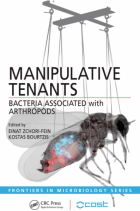
Ecology and Transmission Strategies of Entomopathogenic Nematodes

The High-speed Rail: Serving the Planning and Development of Europe's Metropolitan Cities - Summary Reports

Hydrogenases and their Biotechnological Applications - Annual Activity Report

Technische und wirtschaftliche beurteilung der programme fuer den duo-trolleybus-Schlussbericht Thema7

Ecophysiology of Acid Stress in Aquqtic Organisms

Manipulative Tenants: Bacteria Associated with Arthropods
- Pages: 306
- Author(s): Zchori-Fein, E., Boutrzis, K. (Eds.)
- Publisher(s): CRC Press
- https://www.crcpress.com/Manipulative-Tenants-Bacteria-Associated-with-Arthropods/ZchoriFein-Bourtzis/9781439827499
Manipulative Tenants: Bacteria Associated with Arthropods introduces the fascinating world of bacteria-arthropod associations with an emphasis on the bacterial partner. Written by an interdisciplinary team of international contributors, this book provides an overview of the diversity of bacterial symbionts identified to date as frequent partners of terrestrial arthropods. It discusses primary (obligatory) symbionts as well as the most abundant secondary (facultative) symbionts currently known.

Handbook of High-Temperature Lead-Free Solders, Volume 3: Group Project Reports
- Pages: 302
- Author(s): Edited by A. Kroupa
- Publisher(s): COST
- ISBN/ISSN: 978-80-905363-3-3
Volume 3 of the final publication of Cost Action MP0602, “Handbook of HT Lead-Free Soldering: Group Project reports”, comprises of a set of Group Project reports detailing work carried out during the course of the Action.

Meteorologische Zeitschrift (Vol. 15, 2006, N°1) - Special Issue COST 720 TUC
- Pages: 128 pages
- Author(s): M. Hantel
- Publisher(s): Gebruder Borntraeger
- http://www.schweizerbart.de/j/met-z/
- ISBN/ISSN: 0941-2948 | 0941-2948
The International COST 720 Temperature, humidity, and Cloud profiling experiment (TUC) was organized in winter 2003-2004 at Payerne, Switzerland, to test the ability of ground-based remote sensing systems to measure under cold and stable weather conditions, including situations where fog was present. This special issue focuses on advantages and limitations of such automatic systems for measuring temperature and humidity profiles within the planetary boundary layer, as well as cloud characteristics. Data from two microwave radiometers, one cloud-radar, one ceilometer and one wind profiler were analyzed and validated using radio sonde data, or compared with GPS and satellite measurements. A first attempt to integrate information from various systems to improve the overall accuracy of temperature and humidity profiles is then presented in this special issue.
